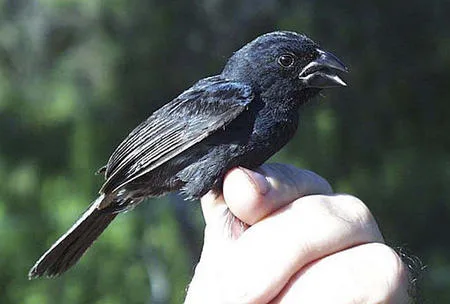
Carrizal Seedeater
[order] PASSERIFORMES | [family] Cardinalidae | [latin] Amaurospiza carrizalensis | [UK] Carrizal Seedeater | [FR] Pic a couronne rouge | [DE] | [ES] | [NL]
Subspecies
| Genus | Species | subspecies | Breeding Range | Breeding Range 2 | Non Breeding Range |
| Melopyrrha | carrizalensis | ||||
| Amaurospiza | carrizalensis | SA | se Venezuela |
Physical charateristics
Male is glossy blue-black with sooty black wings and brighter blue shoulder. Underwing coverts and axillars are white. Bill is large, deep and conical, dark grey. Female is light buff-brown with an olive-grey bill.
| wingspan min.: | 0 | cm | wingspan max.: | 0 | cm |
| size min.: | 0 | cm | size max.: | 0 | cm |
| incubation min.: | 0 | days | incubation max.: | 0 | days |
| fledging min.: | 0 | days | fledging max.: | 0 | days |
| broods: | 0 | eggs min.: | 0 | ||
| eggs max.: | 0 |
Range
South America : Southeast Venezuela. Amaurospiza carrizalensis was recently described following collection of the holotype on Isla Carrizal in the Rio Caroni, Venezuela.
Habitat
It has been found in stands of spiny Guadua latifolia and Ripidocladus spp. bamboo forest, and at least four of the recent localities the birds were in or next to stands of Guadua angustifolia
Reproduction
No data
Feeding habits
Its bill shows some degree of specialisation for feeding. From stomach content analysis of collected specimens it is known to feed on weevil spp. which may be specific to its spiny forest habitat
Conservation
This recently described species was known from a single location where its habitat has now been destroyed. It has since been found at several locations near to the type locality, but it is likely to have an extremely small population occupying a tiny range. Further surveys are urgently needed, but on current knowledge it qualifies as Critically Endangered.
Habitat at the type locality was all destroyed during the development of the Guri Dam, which subsequently flooded this location. This development also destroyed other potentially suitable habitat in this area. Total forest clearance is the principal threat to any other populations that exist
Habitat at the type locality was all destroyed during the development of the Guri Dam, which subsequently flooded this location. This development also destroyed other potentially suitable habitat in this area. Total forest clearance is the principal threat to any other populations that exist

Migration
Sedentary throughout range.
Distribution map

